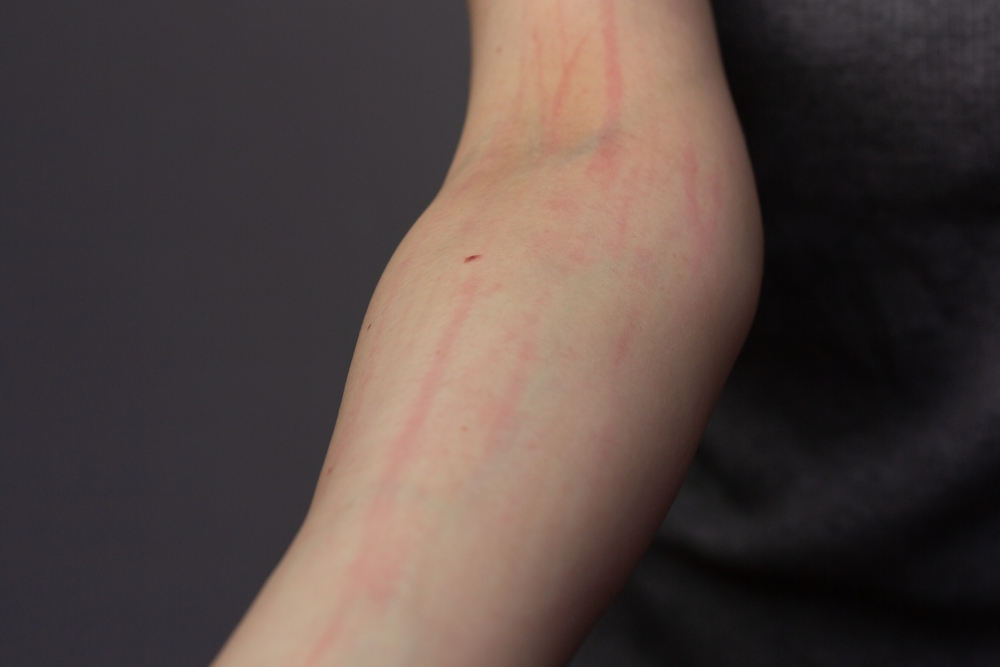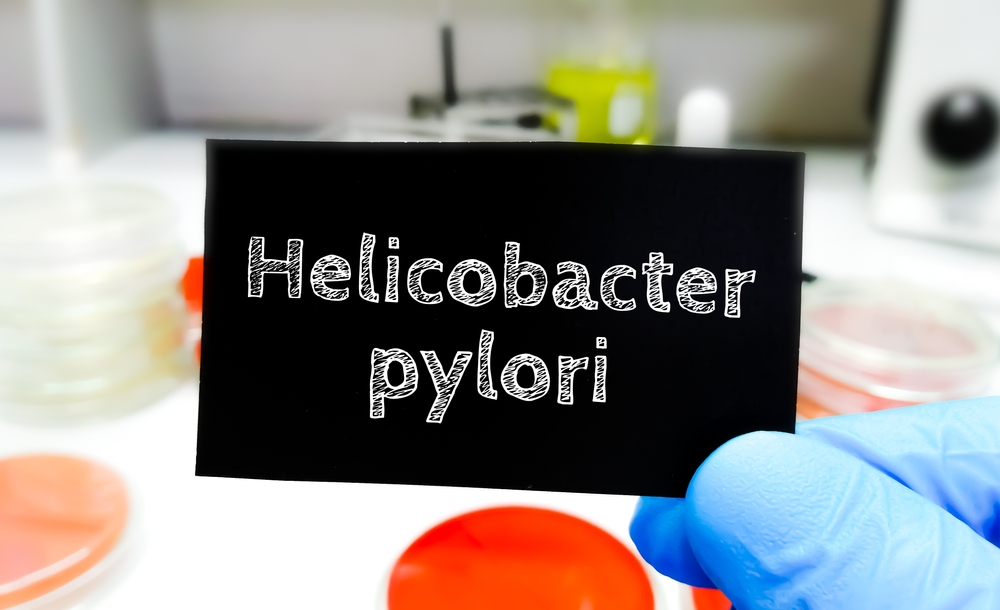What's On This Page?
ToggleLast week, one of our readers reached out with a puzzling skin condition that left her feeling physically uncomfortable and emotionally drained. She couldn’t help but wonder if it was an allergic reaction to a new supplement or food, or the C*V1D booster shot she had received weeks before. The confusion of what it could be made the situation even more frustrating. Today, let’s talk about all this as I shed some light on the intriguing skin disorder known as dermatographia.
Dermatographia is also known as “dermographism.” This is a condition in which the skin becomes overly sensitive to touch or pressure, and when scratched or stroked, it raises in a red, itchy welt or hive-like reaction.
Sometimes you’ll see it referred to as the “skin writing” disease because of it’s name. The name “dermatographia” comes from the Greek words “derma” (skin) and “graphos” (writing), which describes the characteristic of the skin being able to display a visible reaction when it is scratched or written on.
Interesting Facts about Dermatographia:
Dermatographia is a relatively common skin condition, affecting approximately 2-5% of the population worldwide. It has to do with mast cells which dump out histamine. They become hypersensitive and release histamine when your skin is scratched, or pressure is put upon it.
The severity of this condition varies greatly from person to person. Symptoms can vary widely among individuals, ranging from mild redness to more pronounced raised welts resembling hives. Apart from scratching or pressure, dermatographia can also be triggered by emotional stress, heat, or certain fabrics coming into contact with the skin.
Does it go away? Possibly for some, while in others it may persist for months or years. We just don’t have a clear answer across the board. As for the C*V1D vaccines and boosters, it is a possible reaction, at least for one brand, possibly others. The data is not in for all of them. But the booster shot was the tipping point for the person that wrote to me with her new condition. Even her physician concurred it was the booster, not a supplement. This type of skin reaction can be delayed by 2 – 3 weeks so it would be difficult for a person to connect the dots. Here are two articles you can read if you’re interested:
https://www.cureus.com/articles/100751-covid-19-vaccine-booster-induced-dermatographism#!/
Also see this: https://onlinelibrary.wiley.com/doi/10.1002/clt2.12206

Organisms Associated with Dermatographia
In a December 2021 study in Experimental Dermatology, a study was conducted to try and understand how bacteria in the gut (gut microbiota) were related to dermatographia. The scientists compared the gut microflora of people with the condition to a healthy normal group. They found that the types and amounts of gut bacteria were different between the two groups.
They discovered that certain bacteria, like Subdoligranulum and Ruminococcus bromii, could be helpful for diagnosing dermatographia. Also, a bacteria called Prevotella stercorea was related to how long someone had the skin condition.
The study also suggested that the way certain substances are broken down in the body (like pyruvate, butyric acid, and histamine) might be involved in causing the disorder.
They concluded that there are obvious changes in gut bacteria in people with dermographia, and some very specific types of bacteria might be linked to it. This information means that your GI health can not only confirm if you have the disorder, but also suggests you might be able to control symptoms and severity by improving gut health with skin-loving probiotics and a healthy diet.
I just want to make one other quick point. Imbalances in your gut microbiota, including reductions in Verrucomicrobia and Ruminococcaceae, are associated with inflammatory bowel diseases and autoimmune conditions. You see these sometimes in Crohn’s disease and colitis and other conditions related to gut dysbiosis.

H. pylori.
There are some pathogens in the gut that are implicated and thought to create higher risk for dermatographia. One such bug is H. pylori, which is the bacterium known to cause gastric ulcers. This suggests to me that gut health should be a priority for people with dermatographia, and the use of probiotics would be critical.
Yeast and Fungi.
Certain yeast and fungal infections have been reported to trigger dermatographia-like symptoms in some individuals. However, is there a direct correlation as in “cause and effect” or is it a peripheral finding? I don’t know, but again probiotics hold value for gut health.
7 Potential Treatments and Ways to Manage Dermatographia:
- Antihistamines: Over-the-counter or prescription antihistamines can help reduce histamine release and alleviate the symptoms of dermatographia. Natural ones like DHQ, Vitamin C, or Quercetin could help.
- Topical Steroids: Corticosteroid creams or ointments can be applied to the affected skin to reduce inflammation and itching. Hydrocortisone would be an easy-to-find affordable tube of help!
- Avoid Triggers: Identifying and avoiding triggers such as scratching, pressure, emotional stress, and certain fabrics can help manage the condition.
- Cold Compresses: Applying cold compresses to the affected area can help soothe itching and inflammation.
- Immunosuppressive Medications: Something like a low-dose steroid could help. These require prescription. In severe and persistent cases, dermatologists would consider this type of immunosuppressive medication to control symptoms. Aside from steroids, there are other medications too. Due to potential side effects, they are lower on my list of treatment strategies.
- Exercise: There is a STUDY from March 2023 that was published in The Journal of Allergy and Clinical Immunology. It has to do with how exercising can help, and how eating might impact severity! The researchers wanted to find out how common it is for eating or exercising to affect the severity of this condition. They tested 75 people with symptomatic dermographism, some before and after they ate, exercised, or did both.They found that in 13% of the participants, eating certain foods made the skin condition worse (food-dependent symptomatic dermographism).In 66% of the patients, eating didn’t cause a big impact, but it still made the condition worse (food-exacerbated symptomatic dermographism). And in 21% of the patients, eating had no negative effect on the skin condition.They also saw that exercising improved the skin condition in 83% of the patients. That’s really significant! When they exercised after eating, it protected half of the participants with food-related symptomatic dermographism from making their condition worse. But it was better to exercise after eating (67% improvement) compared to exercising before eating (35% improvement). In conclusion, this particular study found that eating can often worsen the condition, whereas, can improve it.
- Probiotics: We know the gut is involved. Probiotics are beneficial bacteria that promote a healthy balance of gut flora. They are known to have potential benefits for gastrointestinal health and may indirectly influence immune function. While some studies suggest a link between gut health and skin conditions, the direct impact of probiotics on dermatographia remains unclear.
What About Milk?
I’ve seen people on forums discussing whether or not dairy allergies and casein (or whey) may be problematic to those with dermatographia. While allergies to dairy are quite common, and sometimes severe, they typically manifest as an immune reaction.
With that you might see more systemic issues, like a headache, gastrointestinal pain, diarrhea, bloating, etc. You might also see fatigue and other full-body problems. You may or may not see dermatographia which again is a specific response to scratching or pressure and mast cells in the skin releasing their histamine. So I’d say that your cup of yogurt is probably not the cause.
But again, it’s important to consult with a healthcare professional that deals with allergies since I am not one. I’m just trying to share some points about the condition so you can get a quick education and pose the real questions to your doctor who has your full medical history and specific circumstances.
Summary
In conclusion, dermatographia is a unique skin condition that affects a significant percentage of the population worldwide. The condition arises from the hypersensitivity of mast cells in the skin, leading to an exaggerated release of histamine when the skin experiences pressure or scratching.
While it might look alarming and red, dermatographia is typically harmless and poses no significant medical risk. However, its impact on an individual’s quality of life can vary, with some experiencing only mild discomfort while others may find it more bothersome.
Though the exact causes of dermatographia remain a subject of ongoing research, studies have explored potential associations with certain medications, vaccines, and even infections. In May 2023, a paper was published about N95 masks. Sometimes, healthcare workers (and even regular people) wear those special N95 masks, but wearing these masks can cause their faces to get red, itchy and develop a rash. It could even cause dermographia according to this FINDING.
While dermatographia might be an unusual skin condition, it is one that can be managed effectively with the right approach. If you or someone you know experiences this intriguing “skin writing” phenomenon, remember, knowledge is power, and with the right knowledge, we can empower ourselves to embrace our uniqueness and thrive in our skin.
It can sometimes coexist with eczema or psoriasis. While dermatographia is a separate condition characterized by the skin’s hypersensitivity to pressure or scratching, individuals with eczema or psoriasis may also experience dermatographia-like symptoms. You might be interested in my article entitled, 10 Novel Treatments for Chronic Itch, Eczema and Skin Infections.
It is usually not considered a serious medical condition, and it’s fairly harmless. But it can be uncomfortable and cause itchiness or irritation. It occurs due to an exaggerated release of histamine in response to pressure or scratching on the skin. Controlling histamine is important. I’ve discussed how to do that in my ebook on Hashimoto’s which you can DOWNLOAD HERE.
Dermatographia can often be managed to some extent with antihistamines which obviously control histamine. These are available over-the-counter, and also by prescription. Read my article on The 5 Best Natural Antihistamines.
Stay curious, stay informed, and stay fabulous!

Suzy Cohen, has been a licensed pharmacist for over 30 years and believes the best approach to chronic illness is a combination of natural medicine and conventional. She founded her own dietary supplement company specializing in custom-formulas, some of which have patents. With a special focus on functional medicine, thyroid health and drug nutrient depletion, Suzy is the author of several related books including Thyroid Healthy, Drug Muggers, Diabetes Without Drugs, and a nationally syndicated column.



